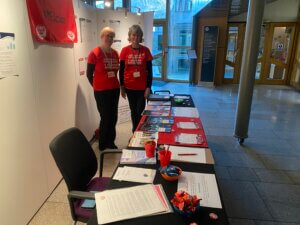Professor Ron Davis presented new findings from his Big Data study at Friday’s Invest in ME 2016 conference. Davis’s preliminary data show serious problems with the biochemical processes needed to convert sugars and fats from food into energy the body can use. If these findings are replicated, this could prove a major step forward in understanding ME/CFS.
Davis’s study is unusual: it’s small with just twenty patients and ten controls, yet generated two billion data points; in fact, the researchers’ biggest problem is dealing with so much data.

The purpose of the study was to collect a prodigious amount of data and use it to identify biomarkers. The study examined a huge number of aspects of patient biology including immunology, proteomics (the production and interplay of proteins), and gene expression. But the main finding revealed at the conference related to metabolomics, the “systematic study of the unique chemical fingerprints that specific cellular processes leave behind”. Metabolomics can help to reveal what’s going on, and what’s going wrong in cells.
Metabolomics is very expensive because it needs some very high-tech equipment, and that limits sample size. The study was only possible because the work was done at cost by new company Metabolon. In fact, Ron’s son Whitney Dafoe was the first person ever studied using Metabolon’s new process. So far, just three sick patients were studied, and were compared with 43 controls.
Tiny sample, huge differences
To find a meaningful difference in such a small sample would usually be impossible – only an enormous difference between patient and controls could be statistically significant because so much variation could be down to the “random noise” of chance. In this case, the differences were vast enough to be considered significant; and, as Professor Davis told the audience, studying three people is not a big study but in personalized medicine, you can learn from just one patient.
Professor Davis illustrated just how big the difference is by using standard deviations, the most common measure of differences in science. The standard deviation is a measure of how much the data within a sample varies on a particular variable, such as people’s height or blood sugar. At least one data point from Whitney Dafoe’s energy metabolism molecules was 16 standard deviations away from the average of the control group. To put that into perspective, 99.7% of all data should fall within three standard deviations away from the average in either direction, and only 0.3% beyond that boundary. The more standard deviations the data is from the average, the less likely that the difference is due to chance. Findings from ill patients that are sixteen standard deviations away from the average in healthy patients is extraordinary.

Researchers were able to determine these errors by looking at the molecular byproducts of the cell and noting abnormalities in the compounds usually consumed and generated by these reactions. The basic biochemical process to turn sugars from food into energy molecules just wasn’t delivering for patients.
This might not surprise many patients, but it’s big news in the world of ME/CFS research. There have been findings along these lines before, notably on the second of a two-day maximal exercise test (the day one test results look normal), and in a study on the products of glycolysis in the blood and urine of ME patients by Christopher Armstrong and colleagues.
More research is needed to replicate these findings, and such a study is already in the works; but this could be the start of a dramatic shift in the field.
Ron Davis, who has previously studied patients with physical trauma also noted that mitochondria “shut down” in these patients and said that a key question is why they don’t start up again in ME/CFS patients.
Davis said that his son Whitney showed errors in B-vitamin metabolism, resulting in a very rare deficiency of biotin; this is important, because enzymes in the citric acid cycle are dependent on biotin. In another patient, tryptophan metabolism was a problem.
Professor Davis’s talk generated excitement both at the conference and among those following the Twitter coverage. His wife, Janet Dafoe, commenting on his talk, said that his team hoped to work quickly towards tests for personal biomarkers for all patients. She said of the research, “We know it’s frustrating and that people are rightfully chomping at the bit! So am I! Every morning… when I wake up, he brings me coffee and I quiz him about what has happened that day so far. I wish you could all be flies on the wall. It’s so exciting. If everyone knew all of what he’s doing, I can’t believe he wouldn’t get big funding.”
Donations can be made to Professor Davis’s work via the Open Medicine Foundation. Janet Dafoe has noted some confusion in regards to the OMF, the OMI, and the CFS Research Center; donating to the Open Medicine Foundation is the best way to make contributions.
And get your conference DVD here!
Invest in ME has just published its annual journal, which includes abstracts from the conference. The abstract for Professor Ron Davis’s talk is posted below.
Please note that this article is based solely on tweets from Phoenix Rising’s team and Maija Haavisto, who were at the conference. Huge thanks to them: tweeting on the fly about a technical presentation is not easy. The article has not been checked with Professor Davis, and any errors are ours. Jaime S and Alex made significant contributions to this article.






30 thoughts on “Ron Davis: Preliminary data shows problems with energy metabolism”
Great article! Thank you! I’ll have him read it when he gets home to make sure….
Thanks so much, Janet!
-J
Thanks, Janet. We’ll be keen to correct any errors.
Ron says this is great! You really got the main points. It’s amazing you were able to do that using tweets! He says thank you for doing such a good job!
Awesome, Janet! Really glad to hear it. Please thank him as well; what he is doing is incredible.
-J
Great to hear – thanks to the tweeters (Phoneix Rising, @aboutmecfs, and Maija Haavisto, @DiamonDie), and even more to Ron.
Simon, good job but just so readers can find more info on web pls. correct
Phoneix Rising = typo, should be Phoenix Rising
This is the BEST news I’ve heard since I became ill 21 years ago!!! 🙂 I wish I could win Lotto & make a huge contribution to the funding. But will donate what I can as soon as possible. I’m sure every little bit counts. Thank you from the bottom of my heart to Ron Davis, & all others involved in the research. Also thanks to Janet Dafoe for keeping us in the loop. I’m trying not to get too excited, as that will bring on a ‘crash’, but it’s hard not to with such progress. ME/CFS patients have been ignored, swept under the carpet for so long, & left to rot on the scrap heap. I hope research such as this will change that!!
Amazing and so exciting, thank you team.
Thank you so much Ron, for all the work you are doing, it’s incredible how much you’ve achieved while having a severly sick son to care for as well. Sending both you and Janet a hug. And Whitney, some pain free gentle vibes! I have so admiration for you all.
Let’s hope the government(s) wake up soon and start realising what me/CFS is costing them.
Xoxo
Thanks for the article and impressive job tweeting on the fly, and thanks to Invest in ME for enabling this by bringing Ron Davis to London for their 11th international conference and also to meet and discuss with other leading biomedical researchers from around the world at the Biomedical Researchers into ME Colloquium over the two days prior to the public conference.
Janet Dafoe @JanetDafoe tweeted Jun 1
Ron just called. He’s excited. He’s making lots of good connections and finding scientists that are on his wavelength about what causes CFS! https://twitter.com/JanetDafoe/status/738079471832436737
Invest in ME Research has no paid staff and receives no government grants.
The charity is run by parents of children with severe ME and patients, working extraordinarily hard over the 10 years since they registered as a charity and held their first conference, to bring the world’s leading biomedical researchers (current and potential) together with patients and politicians to make change happen. Full info on all 11 International Invest in ME Conferences & 6 Biomedical Researchers into Colloquiums, including the Invest in ME Research Conference Reports, Journal, CPD-accredited DVDs is on this site – http://www.investinme.eu
Invest in ME has done a great job, both with the conference itself and the two-day colloquium for researchers before it (which plays such a big part in bringing researchers together and developing research). Just ordered my DVD
Excellent Simon, could you add a link to the conference site in the article? I rely on the DVDs as I’ve been housebound for the past seven years and hadn’t heard of Invest in ME before then, so have never been to the conference and your tweets bring it alive until the DVD arrives! Even so, as I said on the OMF Facebook page, I miss the opportunity for the informal interaction. Thanks again.
Done, Jo! Check out the link in the first line of the article.
-J
Thank you Jaime!
This is exciting and hopeful!
Thinking that Northern Ireland should financially support this work!
Awesome, write up, thank you. And ofcourse to Ron, Janet, Whitney, Linda and the whole OMF team. Remarkable.
Much love
Ben
It’s so good someone is doing basic research on the biochemical causes/deficits in ME. It’s such a great start! Given that the study was done on three severly ill patients, how will it be verified that this is the cause for all ME patients up to those “midly” affecteded (50-70%) functioning? These findings, if replicated, will they be considered biomarkets?
Long way to go still on replication and verification. As I understand things, there is another metabolomics study due for publication on a different patient sample finding similar things (Dr Naviaux), and plans for a further replication. But perhaps someone with better information than me can comment.
I don’t think they’re necessarily expecting to find a single cause for all patients diagnosed with ME/CFS, regardless of severity, just that they have to start somewhere and that any signals should be stronger in the most severely ill, and this also fits with the trend towards personalised medicine. It’s also in the context of a number of biomedical researchers working on various pieces of the puzzle at other centers in USA and around the world, able to share and discuss, thanks to the opportunities provided by the Invest in ME Conference & Biomedical Researchers into ME Colloquium. This was Ron Davis’s first time there (and I think was the first to sign up for it this year) but Linda Tannenbaum, now Executive Director of OMF, has been before, and gave the pre-conference dinner speech in 2012.
Isn’t this precisely what Dr. Sarah Myhill has been saying since 2009? I’m surprised her work isn’t given any credit here.
http://drmyhill.co.uk/wiki/CFS_-_The_Central_Cause:_Mitochondrial_Failure
The idea of mitochondrial dysfunction has been a popular one, supported in theory by many scientists, patients, and clinicians before 2009. Research into mitochondrial dysfunction in ‘post-viral fatigue’, CFS, and ME goes back at least to the mid-1980s (and perhaps before). Here’s a 25 year old paper that suggests that mitochondrial abnormalities might be at least part of the problem:
http://www.ncbi.nlm.nih.gov/pubmed/1792865
It is hard to demonstrate who first had a particular thought about the illness. It’s more a problem of getting the time, money, and resources to test those hypotheses, and get enough data to publish. And then to get enough time, money and resources to demonstrate the findings can be replicated by a second research team.
And part of the problem in getting all of these things done was the perceived lack of ‘respectability’ of CFS as a diagnosis. Researchers used to say if you studied it, you were tanking your career. I’m very glad that people at Stanford and Columbia are changing that perception.
-J
Are you aware of Horizon 2020? It is a program on the European Union where you could get funding for really high values. Please, explore that. Keep on the noble cause of finding the solution for ME/CFS!
Abstract for Professor Ron Davis’s talk, from the Invest in ME journal with conferencce abstracts. PDF at
http://www.investinme.org/Documents/Journals/Journal%20of%20IiME%20Vol%2010%20Issue%201.pdf
“While we were seeking funding for the Big Data Study we tested some of the technologies on a few severe and not severe CFS and healthy control patients.
We discovered that the metabolome (the small metabolites found in the blood and urine) of the serium gave clear indication of metabolic abnormalities.
Preliminary results indicated that glycolysis may be impaired with glucose being routed to fatty acid synthesis.
Possibly more important, the metabolites in the citric acid cycle in the mitochondria were lower than in healthy controls and some almost undetectable.
This cycle generates most of the energy (ATP) for the body. It makes it clear that this is no psychosomatic disease. From preliminary analysis it would appear that not only ATP is low but also ADP, AMP, GTP and in some cases uracile.
These cofactors are involved in hundreds of molecular reactions in the body including in the brain. Their decrease would cause a large number of body functions to be abnormal.
We don’t know which cells in the body are being affected (possible all cells) and are currently studying the various white and red cells with a variety of commercial and custom technologies.”
Great report! A huge thanks to everyone who contributed. It’s really cool being able to keep up with what Dr Davis is investigating.
Whitney’s biotin deficiency is intriguing. Biotin supplementation is showing promise for progressive multiple sclerosis:
“High doses of biotin in chronic progressive multiple sclerosis: A pilot study”
http://www.sciencedirect.com/science/article/pii/S2211034815000061
Yet another link between MS and ME?
If the FXRnuclear receptor in the liver regulates metabolism,bile acids and immune response,could it be that abnormalities in metabolism might be caused by interactions with other chemicals regulated by the same receptor?I suspect that my CFS is undiagnosed liver damage and I think that there are gaps in research regarding diagnosing some types of liver damage ,the participation of the liver in the immune response,the detoxification of chemicals in the liver(if impaired because of damage to parts of the liver)and how some of those reactions might intersect(eg orosomucoid is involved in the immune response and it is also a carrier for some of the chemicals that are detoxified by the cytochrome P-450 enzymes.I have a couple more examples like that.)
I’ve seen liver involvement in CFS personally. If your body is under a lot of oxidative stress and/or dealing with chronic infection, the liver is probably under strain detoxifying and processing the resulting hepatotoxic junk. However, if we look at the illness from the pathogenic angle, it may be that there are some individuals in which a pathogen or pathogens has infected the liver.
The P450 enzymes catalyze an enormous number of reactions (they also activate when you eat a piece of broccoli!) Their position in the ER and mitochondria, their effect on hormone production etc may mean that CYP450 abnormalities are in a subset of ME patients.
Challenging that now we are in ‘wait and see’ mode. 😉
-J
Putting it in economic terms of supply and demand, it strikes me that there are two obvious solutions as to why the fatty acid synthesis pathway is being favored.
Firstly there could be an acquired metabolic defect which blocks the pathway in people with ME, such as some toxin, leading to extraordinary upregulatory signalling as a compensating mechanism.
Secondly fatty acids could be being targeted and used up at a very high due to some aspect of immune upregulation, for example some innate or adaptive pro-inflammatory factor(s) leading to fatty acid damage and turnover.
As an example which would support this second conclusion there’s already been a study finding increased isoprostanes in ME and correlating with physical symptoms here:
http://www.ncbi.nlm.nih.gov/pubmed/16085177
In reply to Jaime’s comment above, maybe if there is an increased turnover of fatty acids maybe the liver cannot handle this continuously, leading to a mild increase of liver enzymes on a standard blood panel.
TYVM for the writeup!
Really interesting. As my ME symptoms have increased in severity and I have struggled to maintain a level of activity (work etc) I have experienced an increase in food cravings that seems directly correlated to those times when I am outside of my energy envelope. I have experienced significant weight gain at the same time. Am wondering if this pattern fits into what this paper describes.
Gracias Janet, gracias Ron. Muchísimas gracias desde España.
Comments are closed.